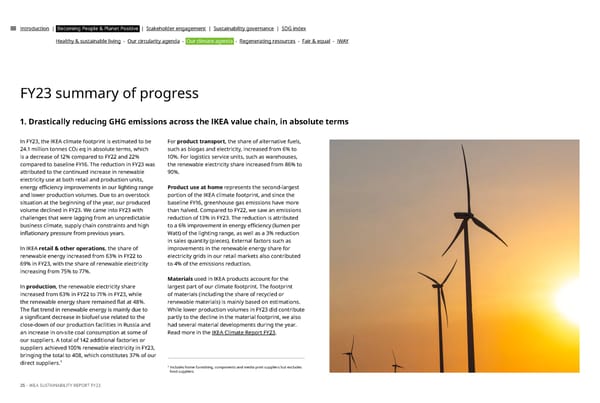Introduction | Becoming People & Planet Positive | Stakeholder engagement | Sustainability governance | SDG index Healthy & sustainable living - Our circularity agenda - Our climate agenda - Regenerating resources - Fair & equal - IWAY FY23 summary of progress 1. Drastically reducing GHG emissions across the IKEA value chain, in absolute terms In FY23, the IKEA climate footprint is estimated to be For product transport, the share of alternative fuels, 24.1 million tonnes CO2 eq in absolute terms, which such as biogas and electricity, increased from 6% to is a decrease of 12% compared to FY22 and 22% 10%. For logistics service units, such as warehouses, compared to baseline FY16. The reduction in FY23 was the renewable electricity share increased from 86% to attributed to the continued increase in renewable 90%. electricity use at both retail and production units, energy e昀케ciency improvements in our lighting range Product use at home represents the second-largest and lower production volumes. Due to an overstock portion of the IKEA climate footprint, and since the situation at the beginning of the year, our produced baseline FY16, greenhouse gas emissions have more volume declined in FY23. We came into FY23 with than halved. Compared to FY22, we saw an emissions challenges that were lagging from an unpredictable reduction of 13% in FY23. The reduction is attributed business climate, supply chain constraints and high to a 6% improvement in energy e昀케ciency (lumen per in昀氀ationary pressure from previous years. Watt) of the lighting range, as well as a 3% reduction in sales quantity (pieces). External factors such as In IKEA retail & other operations, the share of improvements in the renewable energy share for renewable energy increased from 63% in FY22 to electricity grids in our retail markets also contributed 69% in FY23, with the share of renewable electricity to 4% of the emissions reduction. increasing from 75% to 77%. Materials used in IKEA products account for the In production, the renewable electricity share largest part of our climate footprint. The footprint increased from 63% in FY22 to 71% in FY23, while of materials (including the share of recycled or the renewable energy share remained 昀氀at at 48%. renewable materials) is mainly based on estimations. The 昀氀at trend in renewable energy is mainly due to While lower production volumes in FY23 did contribute a signi昀椀cant decrease in biofuel use related to the partly to the decline in the material footprint, we also close-down of our production facilities in Russia and had several material developments during the year. an increase in on-site coal consumption at some of Read more in the IKEA Climate Report FY23. our suppliers. A total of 142 additional factories or suppliers achieved 100% renewable electricity in FY23, bringing the total to 408, which constitutes 37% of our direct suppliers.¹ 1 Includes home furnishing, components and media print suppliers but excludes food suppliers. 25 - IKEA SUSTAINABILITY REPORT FY23
 IKEA ESG FY23 Report Page 24 Page 26
IKEA ESG FY23 Report Page 24 Page 26This is a modal window.
